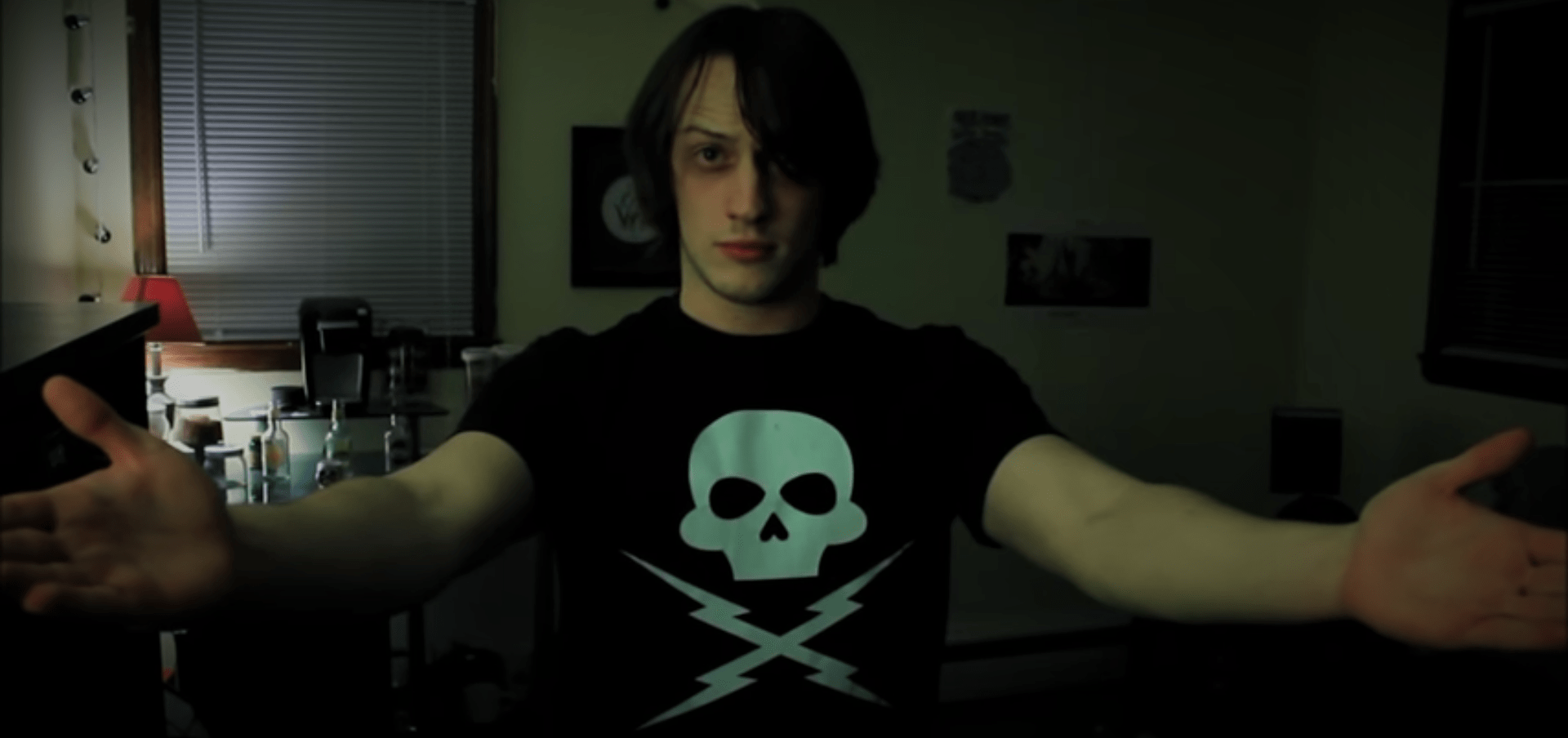“You see the journey starts here, the real fun starts here, when everything changes…”
– Evan Jennings as Habit
We’ve charted a course through two alternate reality games on Serious Play. We investigated the voyeuristic view of This House has People in It and uncovered a misplaced N64 cartridge in Catastrophe Crow 64. I’ve been musing about starting up a show dedicated to these kinds of experiences for a while now. Summer’s moving slow in Milwaukee, and that means between my biking escapades I’ve got time to finally set up shop. This post will act as a treatment for the new Serious Play show, The Ludic Society, which will investigate [in an extended form] the act of playing pervasive games. And while I’m not looking to throw a bunch of theory at you readers this morning [evening, or night], It’s probably important to clear up what mediated pervasiveness entails.
Pervasive games encompass games played with a degree of totalizing “aroundness” to the player. What that means is that the game itself is generative of a space which might be seen to constitute a vast field of play, an augmented/altered reality, or an ebb and flow between virtual and physical space. Perhaps the best visual example of pervasiveness is Yayoi Kusama’s Infinity Mirrors. Pictured here (figure.1) is “Aftermath of Obliteration of Eternity” – one of the collection’s illusory uses of mirrors to project a seemingly infinite space; thereby generating a mediated totalizing

Figure 1.0: Yayoi Kusama’s “Aftermath of Obliteration of Eternity”
aroundness to the viewer. Traditionally this category has only included Alternate Reality Games (ARGs), Augmented Reality Games (AR), and Virtual Reality Games (VR) – but I would contend that many more forms of games can be pervasive. At the very least, Tabletop Role Playing Games (TTRPGs) seem to foster a similar sort of generative aesthetic within sufficient distance of the table. At the very most, metagaming spheres have certain rhythms of pervasiveness – intermingling the modes of play with day-to-day living. Anywhere we can reasonably find pervasiveness, this show will boldly go!
It’s my aim to have The Ludic Society interrogate the relationship between makers and players in the digital age, and the variety of roles that they perform at any instant. Sure, the act of play is in question, but so is the act of making, and the act of standing-by. Hopefully this show will invite on not just designers of pervasive experiences, but players and critics. Any human being moving through a pervasive game has knowledge of their own experience, and that’s infinitely valuable.
Such a show must have a deep engagement with its audience. We ask audience members to act as commentators, annotators, and as guides as we explore notably dense and winding transmedia experiences. In no way will we always know everything or always get everything right – and the process of figuring all of our paths out with the audience is something uniquely accessible to us on twitch. It’s charting a course with the audience [ As if we’re Odysseus himself!], instead of charting a course for the audience. And in that way, I hope the show becomes playful for everyone involved!
Ludic Logistics:
The Ludic Society will meet during the summer on a biweekly schedule for about four hours at a time. It takes a lot of energy to research, chart, and explore any pervasive game or play-community. As much as I’d like to do weekly, it doesn’t seem to me like such a thing would be feasible while I’m the only consistent host. The show will feature a revolving round table of other scholars from within Serious Play and will remain open for anybody who wants to jump on for a game. I’d only ask co-hosts to commit to the show for the duration of any single play experience. I think it’s helpful for our commentary to have continuity, especially if we’re solving detailed narrative puzzles – or cryptography. We will make consistent use of community resources and do the best we can to credit community members for their contributions to any game we play. Communities are the lifeblood of ARGs – and especially for ARG content, I personally want to make sure community members are thanked for the work they are doing. Comprehensive progress documents make our show possible. There’s no way four people on a twitch stream could solve an ARG on their own.
The show will feature webcams prominently. Afterall, we’ll be hopping between focusing on embedded media objects and commenting about what we’ve seen. We might watch a 15-minute video together, and then talk about it for 45 minutes. We’ll also keep our own progress documents, and maybe we’ll make them publicly visible on the blog or on some other site! Could be fun to let the community comment on our progress. And we’ll keep dreaming up new ways to let our viewers help us in our journey. I just don’t want to commit to too much now!
You know, we also make games? Crazy right. No seriously, I’d like the Ludic Society show to have episodes where we draft ideas about different types of games. Even if those designs or stories go nowhere – pitching them and co-working on them is a process of critical making. Designing an escape room can tell you a lot you didn’t know about the process and culture surrounding escape rooms. And I think the same is true of any art form. Obviously, anyone joining us can contribute their ideas.
Moods, Modes, and Memes:
So, all that’s great, but what about the feeling of The Ludic Society. If you had to analogize it to a type of tree what kind of tree would it be? What kind of parking lot? What kind of Seattle-based café chain? I envision The Ludic Society as a play on the general aesthetics of secret societies. Obviously, no iconography will be used without looking into its meaning – but you better bet there will be bizarre symbols, secret handshakes, and an emphasis on archaic physical media. It’s not like the show won’t be aware of it’s existence on twitch, it’s more like we want to have some fun blending stylized graphics with “abandonia”. Is it going to look great day one? No. I’m not a digital artist. Well, I shoot film and take photos – but I don’t draw. So, there will be some growing pains as we reach toward the correct vibes. As I update and work on the show’s graphics maybe I’ll make more blog posts charting the process of drawing from works that inspire me. Turn the process-based show into another process [a nested-ludic society].
As for the vocal/physical performance, I hope we can be monstrously silly while chatting about the ins-and-outs of digital worlds. And maybe that’s all there is to say about that particular beat. Besides, I think the best way to explore theory is to make it accessible. Sometimes accessibility comes hand in hand with humor and casual dialogue. I don’t want this project to feel untouchable to its audience. It would kind of be missing the point, I think.
One little addendum here, the title of the show is a reference to a paper by Jaakko Sternos, Markus Montola, and Frans Mayra called “Pervasive Games in Ludic Society”. While the accuracy of the work is something I openly debate, I think Sternos et al. make a good start to defining the concept of pervasiveness. And their sensibility for titles is truly enviable – thank you three for your scholarship, it’s been a positive influence in my own.
Your go to guide…
So where do we begin on this winding road into the warrens? Well, I’m an ARG scholar by trade so I’ll be starting the show there. We owe a debt to the Catastrophe Crow 64 community. Their attendance during our last ARG outing is what’s propelled me into making this show. So, it only makes sense to start with Crow 64! We’ve already gotten through a fistful of Crow64 content and I’m not sure if it’d be best to revisit that a new stream. If we have different players, or a different audience, it might be helpful to restart at the beginning. But we’ll decide that down the road – post this very official first announcement.
Since we’ll be beginning with an ARG, I also want to take a moment and lay out my five-point definition as to what an ARG is. All definitions are just models to be broken. I’m not saying this describes/will describe all ARGs – it’s just a working set of bullet points.
- ARGs are Games. Granted, that doesn’t necessarily clear anything up. And you can’t pay me enough to define what a game is.
- ARGs are Transmediated. Basically, you need a narrative/ludological continuity across multiple media forms to be an ARG. Again, query what is a distinct media form. I’m not paid enough to answer that in this post.
- ARGs are Networked Narratives. That means all ARGs contain a distributed and emergent narrative. The distributed narrative is spread across the transmediated content [a little here, a little there, on twitter, on YouTube] and must be compiled to be fully read in a single locus. The emergent narrative is the compilation of the distributed narrative, plus the bits and bobs that players insert through their digestion of the narrative. ARGs are therefore co-authored by players and puppet masters.
- ARGs are Community Driven. Basically, in order to play an ARG you need a community of people working together. The game is not reasonably completable by a single person.
- ARGs are Pervasive. Generative of that sense of “aroundness” we talked about, or an altered reality. I use pervasiveness in place of the TINAG [this is not a game] aesthetic, mainly because TINAG is falling out of fashion. Besides, some ARGs act as metacommentaries and therefore, on some level, must recognize their own playfulness in a way that unerring adherence to TINAG won’t allow.
…and ARG is just one way of understanding a phenomenon or media form. It’s good not to be overly attached to any single way of viewing any game/media object. Besides, the important part of any game isn’t its formal elements – but how those elements exist within their contexts. The Ludic Society is ultimately less interested in definitions, and more in doing. Enough babbling! The real fun starts here!
Works Cited:
Butcher, Adam, Catastrophe Crow 64. 2020.
Caffarello, Vincent, Jeffery Koval, & Evan Jennings. “All Good Things” YouTube, uploaded by EverymanHYBRID, 2 Nov. 2018, https://youtu.be/j8mmwZhRtuY
Caffarello, Vincent, Jeffery Koval, & Evan Jennings. “A Summoning” YouTube, uploaded by EverymanHYBRID, 27 July 2013, https://youtu.be/jY6yH6Odmh4
Kysama, Yayoi, “Afterman of Obliteration of Eternity”. 2009, Washington D.C., Hirshorn Museum and Sculpture Garden, https://hirshhorn.si.edu/kusama/infinity-rooms/
Sternos, Jaakko, Markus Montola, and Frans Mayra, “Pervasive games in ludic society”, Future Play , 2007, https://doi-org.ezproxy.lib.uwm.edu/10.1145/1328202.1328209
